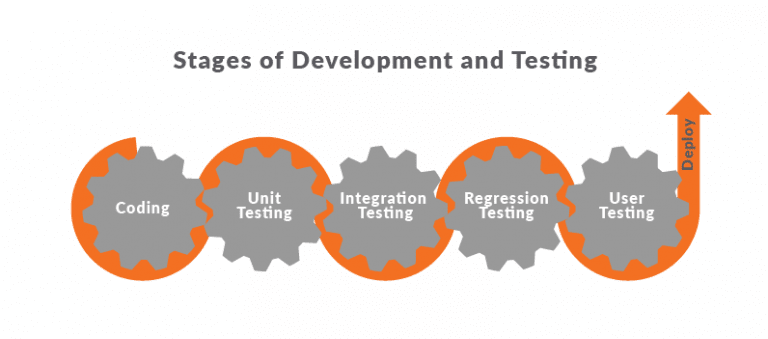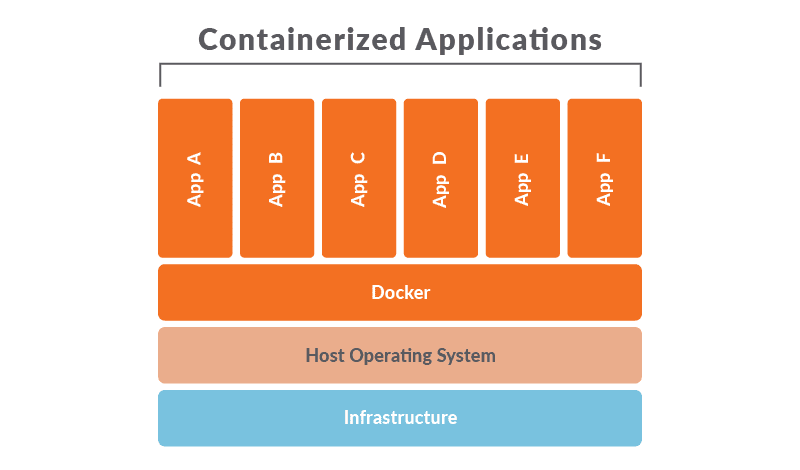Table of Contents
The DevOps approach to mobile app automation acts as a bridge between development and operations by creating a streamlined pipeline and a more productive collaboration between the teams and all other contributors working on a software piece. Utilizing this type of collaboration ensures all departments are on the same page in real-time and that teams involved are properly connected so there are few to no idle intervals during app development.
By streamlining and speeding up the app automation process, a business is able to eliminate any unnecessary costs, shorten the app’s development cycle, get the app to the users more quickly, create a more reliable product, and/or more easily scale the projects and apps that have been growing at high rates.
Ok, now that we’ve covered the imminent and often boring part that is the introduction, we can move onto the good stuff.
DevOps in a Mobile App Development Environment
Adopting the DevOps mindset and utilizing this approach within a mobile app development environment is not exactly an easy process. However, once it is properly integrated, it can make a huge difference for app creators in terms of:
- Productivity
- Efficiency
- App quality
- Reduced costs
- Client satisfaction
- Overall revenue
Most typically, there are 6 main components of the DevOps approach to mobile app automation (though this can vary depending on the app itself). The following stages are those that tie in the entire process together and make sure the product reaches the highest possible levels of quality, security, and user-experience:
1. Planning
The planning stage usually involves all the stakeholders of the app creation process working together to assess the scope of work, choose tools and infrastructure, and set goals (both long-term and incremental). This includes developers, testers, analysts, and the operations team.
2. Mixture-based Code Build
The developers implement a collaborative approach to writing code right from the beginning, therefore ensuring that the code written by one team can be seamlessly integrated with the code built by another. The devs need to make sure all development assets are traceable, including scripts, code, text files, documents, configuration, etc.
3. Automated Testing
The testing stage allows for the quality of a product to reach top tiers. It enables bug identification and problem/error detection early on so any potential bottlenecks can be tackled in a timely manner. With mobile app development, there are more factors influencing the quality of the final product than with regular software. The app has to be capable of running smoothly on a wide range of devices, taking into account the device’s screen size, resolution, features, tech capabilities, OS versions, etc.
This is why the automated testing stage needs to be performed on simulators and emulators, as well within the real environment. Ideally, continuous testing is carried out on actual devices and performed on the very infrastructure it will later be deployed.
4. Continuous Monitoring
In mobile app development, continuous monitoring is automated testing’s twin brother. It makes sure any issues are identified and resolved as they occur during the process with little to no human involvement and interaction. If the marriage between automated testing and continuous monitoring is a steady one and filled with love, the end product will be stable and high-performing, and the users satisfied.
5. Continuous Delivery
If all the DevOps moving parts are working correctly, there should be no delays across the teams and departments. As the app’s code is built, the app is completed and launched. This is made possible through the CI/CD pipeline (more on this later in the article) that allows the changes in code to be deployed as and when the changes are being made.
6. Deployment
The app changes that have passed the process of automated testing are being deployed automatically, thus streamlining the app automation workflow as much as possible.
The benefits of DevOps in mobile app development, apart from increased efficiency and faster turnaround times, include:
→ Improved collaboration
→ More room for innovation and creative thinking
→ A more stable environment for easier deployments
→ Quick delivery time
→ Automated bug fixes
→ Continuous software delivery
→ Improved overall UX
The Advantages of CI/CD in Mobile App Automation

Active Feedback Loop that Increases Visibility and Transparency
In a legacy software development ecosystem, one of the main factors that slow down app automation is slow (or no) feedback. When there’s insufficient feedback about the changes made to the code and the overall impact of those changes on the product itself, the long-term ramifications in terms of productivity and deadlines can suffocate and easily kill the entire project.
Frequent code commits can create an illusion of overall progress as the workflow seems to be moving forward at high rates. But without testing, there’s no active feedback loop to validate the work that has been done by the devs.
This is where the CI/CD pipeline comes into play.
Through the process of continuous integration and continuous delivery, the team is able to streamline the workflow in such a way so there’s near-real-time feedback that makes coding issues transparent and allows for a dynamic communication environment between teams and team members.
Smaller Code Changes and the Prevention of Integration Friction
CI/CD makes the integration of small pieces of code possible. If the code changes and commits come in big chunks, testing and integration can take much longer than necessary. Smaller code changes are easier to tackle, which allows for fewer long-term issues.
Through continuous testing, these smaller code commits get tested immediately after they’re integrated into the code repository. This enables developers to detect issues early on before too much subsequent work has been completed, preventing potential workflow roll-backs that often slow down the project.
Shorter Mean Time To Resolution (MTTR)
This metric measures the maintainability of repairable features. It should be used to set the average time to repair a broken feature and help the teams track how much time is spent on failure recovery.
CI/CD directly shortens the MTTR due to smaller code changes and more easily detectable fault isolations, allowing failures to be kept at a minimum and their recovery to be much quicker.
Improved Test Reliability or “Continuous Reliability”
Higher reliability rates are made possible via the bite-size and specific changes that are introduced to the system, thus making sure the tests conducted (both positive and negative) are much more accurate. This CI/CD concept is often referred to as Continuous Reliability that allows for the continuous merging/releasing of new features and products, with consistent quality levels.
Less-Hefty Backlogs and Less Bugs Detected By End-Users
With a reduced number of non-critical defects in your backlog, the dev team can put larger problems into focus before the release and therefore improve the overall quality of the app. This aspect of mobile app automation makes sure your customers are happy and their app experience is bug-free.
This is extremely important as your app’s UX is what can make or break your product right from the get-go. If the first impression of your end-user is that the app is buggy and not quite as intuitive as they expected, they are highly likely to go with one of your direct competitors.
Reduced Costs / Boosted ROI & Product Quality
All other benefits of an App Automation in the CI/CD pipeline converge in one critical point – reduced costs. By decreasing the number of errors and workflow bottlenecks (and through automated fixes) your team can speed up the entire project and reduce overall costs generated during your app development endeavor. Similarly, the very code quality and reliability increase along with your ROI.
Why Containerization is Becoming the Unavoidable Standard in App Automation
The process of containerization is like an MVP that is often hidden in the shadows. Although it is often avoided in DevOps marketing circles, it is among the crucial components of a successful mobile app automation and development process. Otherwise, it wouldn’t be praised by tech giants like Microsoft, Amazon, IBM, Intel, HP, Red Hat, and VMware.
Containerization, along with the concept of microservices, further improves mobile app automation as it allows the architecture of an app to be divided into multiple services each with its dedicated micro-function within the app. This approach is a giant leap from the legacy software development environment in which all components are located in a single instance.
What Are Containers?
Containers have been evolving over the years, and are currently extremely valuable tools. They represent packages in which you store all the components an app needs in order to function. This includes:
- Code
- Libraries
- Binaries
- Dependencies
It acts as a self-contained, stand-alone unit that improves the app’s development, shipment, and deployment, as well as the hardware requirements.

The relationship between the containers and microservices is that the latter is stored and operated within the former, and although Virtual Machines can be used for these purposes, the container technology takes up less space and allows faster booting.
Main Benefits of Using Containerization/Microservice Architecture In Mobile App Automation:
Less Hefty Codebase
As each service component operates within its own container, the devs can work with a smaller codebase, allowing for:
- simplification of individual tasks
- fewer complexities and dependencies of functions
- shorter development cycle speed by simplifying individual tasks
Utilization of Different App Technology Stacks
Developer teams are able to leverage a wide range of different technologies, from languages to libraries as there is no dependency like on legacy infrastructures.
Scalability on Various Levels
Teams can scale different app components according to the resources, eliminating the need for multiple instances of every component in order to achieve scalability and therefore saving you both time and money.
Compartmentalized Bugs & Failures
In a container-based architecture, there’s a limited dependency. A bug that pops up in one micro-architecture is unlikely to hinder the function of the entire system or any other app component.
Summary
All the advantages of deploying a DevOps approach in an app development environment are yet to be determined. The most obvious ones include cost-effectiveness, better communication among teams and team members, streamlined workflow, more efficient testing, shorter app lifecycle, and shorter TTM.
In order for all these benefits to be fully leveraged, all the moving parts of the DevOps deployment process need to be tackled with high levels of thoroughness and expertise. Otherwise, the expected results may fall short.
